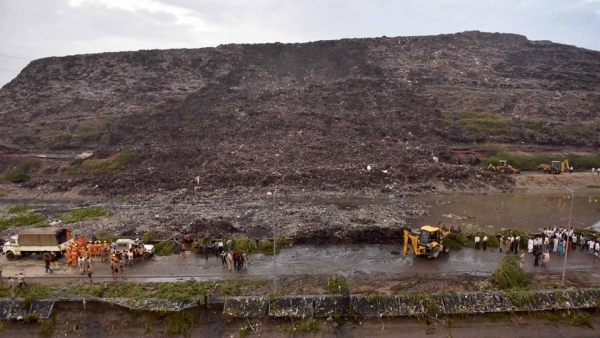Basic Civil Services, New Delhi Trash
"There is absolutely no painless way to fix this waste problem."
"Politicians are not willing to make even one resident unhappy because then that resident will vote for the other party."
Ashutosh Dikshit, chief executive, United Residents Joint Action, Delhi
"We are fourth-class citizens."
"Nobody listens to us. We die like insects."
Mohammed Ismail, 66 business owner, New Delhi
"The height of the dump keeps increasing and my health keeps decreasing."
"We are uneducated people. We do not understand the law, but we do know that this dump is illegal."
"What do I do? Shall I smash my head into a wall? How long can I live here?"
Faiyaz Khan, owner, Buffalo dairy plot, Ghazipur, India
 |
| Rescue operations underway at Ghazipur landfill where a mound of garbage collapsed, in east Delhi. (Prabhat Pandey/HT) |
The land on which one of New Delhi's garbage dumps sits was once a dense forest. It is now the Ghazipur dump. It rises higher year over year. At the present time it is the height of a 17 story-high mountain of trash. About 36.3 billion kilograms of garbage in the metropolitan area of Delhi, including New Delhi accumulates at four official dump sites in the capital already struggling with polluted air and toxic water problems.
But it is these garbage dumps that have become among the largest, least regulated and most hazardous in the international community, according to Ranjith Annepu, co-founder of Waste Wise, a nonprofit environmental group. The Government of India has pledged it plans to eliminate single-use plastic by 2022. Prime Minister Narendra Modi stated "I reiterate our commitment to sustainable development", in a country swiftly overtaking China as the most populous in the world with 1.3-billion people.
The population of Delhi over the last two years has increased to 19 million from 12 million, with infrastructure and services incapable of keeping pace. In that period, waste taken to the dumps has proliferated from 3.6 million kilos to 9 million daily, about half of which is converted to energy or composted, with the rest festering, in he words of P.K. Khandelwal, chief engineer of the East Delhi Municipal Corporation.
The Ghazipur dump wafts particles to nearby residents infecting neighbourhoods with tuberculosis and dengue fever. It has turned ground water yellow, and singed nearby trees with the noxious toxicity of its presence. And it proved its instability even as trucks rumble over it depositing greater amounts of trash daily, when a tower of trash became unstable during monsoon rains last year and crashed into a canal nearby, creating a surge of sewage, and two people died.
The problems of the dumps and their administration intersect both municipal and national government agencies, controlled by different political parties, hesitant to annoy people who depend on the dumps and their contents to sift through for salvageable items for sale, representing their living income. Residents of Delhi might or might not use trash cans placed on streets; they have been long accustomed to flinging their trash anywhere, leading to piles of refuse everywhere.
 |
| Photo: CivilEngineer |
According to Mr. Khandelwal of the East Delhi Municipal Corporation, the government is unable to find land suitable for the opening of new dumps. Politics come into play when hundreds of thousands of ragpickers living in nearby slums tend to protest over safeguarding their source of income. At an estimated cost of $75 million it would be possible to collect the Delhi waste and convert the dumps into sanitary landfills.
But the condition of the Ghazipur dump seems secure at this point, with no solution on the near horizon to its fallout where skin infections run rife, suffocating asthma attacks complicate the lives of residents, and heart arrhythmias have become common. Government has promised to shut the dump down after last year's collapse and area residents question why nothing has yet been done and the dump continues to grow.
 |
|
It is 50m tall, spreads over 70 acres and has received 13 million tons of garbage up to now Photo: Civil Engineer
|
Labels: Environment, Human Rights, India, Pollution, Trash

<< Home